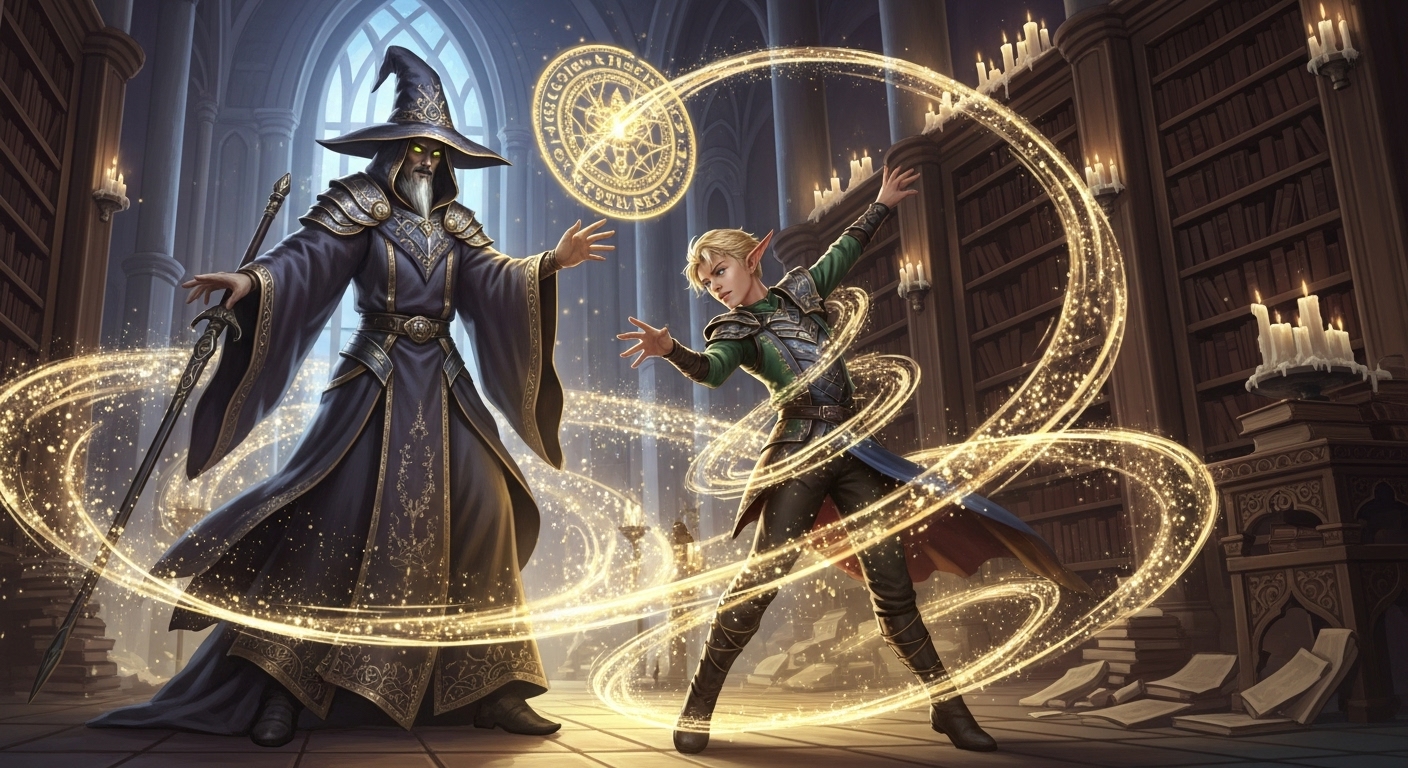Irresistible Dance

- Level: 6
- School: Enchantment
- Class: Bard, Wizard
- Casting Time: Action
- Range: 30 feet
- Components: V
- Duration: Concentration, up to 1 minute
One creature that you can see within range must make a Wisdom saving throw. On a successful save, the target dances comically until the end of its next turn, during which it must spend all its movement to dance in place.
On a failed save, the target has the Charmed condition for the duration. While Charmed, the target dances comically, must use all its movement to dance in place, and has Disadvantage on Dexterity saving throws and attack rolls, and other creatures have Advantage on attack rolls against it. On each of its turns, the target can take an action to collect itself and repeat the save, ending the spell on itself on a success.
Tactical Usage
High-Value Target Control: Irresistible Dance provides powerful single-target control against dangerous enemies. The spell forces movement expenditure while imposing significant combat penalties, effectively removing threats from combat effectiveness.
No Initial Save: Unlike many control spells, Irresistible Dance has no initial saving throw, making it reliable for controlling important targets. The repeat saves occur on the target's turns rather than preventing initial effects.
Positioning Advantage: The disadvantage on Dexterity saves and attack rolls, combined with advantage for others attacking the target, creates significant tactical advantages for focused fire strategies.
Spell Combinations
Opportunity Attack Setup: Since the target must use all movement to dance in place, they cannot move to provoke opportunity attacks. However, allies can position for advantage on attacks against the dancing target.
Area Effect Synergy: The dancing target has disadvantage on Dexterity saves, making them vulnerable to area effects like Fireball or Lightning Bolt that require Dexterity saves for reduced damage.
Hold Monster Comparison: While Irresistible Dance doesn't paralyze like Hold Monster, it provides reliable control without the paralysis immunity that some creatures possess.
Material Component Details
Verbal Component Only: The spell requires only verbal components, making it extremely reliable to cast. No material components mean consistent availability regardless of equipment or environmental restrictions.
Musical Casting: The verbal component likely involves musical elements - singing, chanting, or rhythmic words that compel the target to dance. This creates thematic casting opportunities.
Enchantment Focus: The purely verbal nature emphasizes the spell's enchantment school, relying on magical compulsion through sound and rhythm rather than physical components.
Creator Notes
Success Conditions: Even successful saves only grant temporary relief until the end of the next turn. The spell's persistence makes it valuable for maintaining control over multiple rounds.
Creature Limitations: Some creatures might be immune to charm effects or lack the physical capacity to dance, limiting the spell's universal applicability.
Social Implications: Using Irresistible Dance in civilized areas creates unusual social dynamics, as the effect appears humorous rather than threatening to observers.
Environmental Interactions
Space Requirements: The dancing requires space for movement, potentially being less effective in cramped quarters or areas with difficult terrain that restricts dancing motion.
Musical Environment: In areas with existing music or rhythmic sounds, the spell might blend more naturally or gain additional thematic resonance with environmental audio.
Floor Conditions: Different surface types might affect the dancing - smooth floors allow graceful movement while rough terrain might make the compulsive dancing more awkward or painful.
Common Rulings & Clarifications
Movement Restriction: The target must use ALL movement to dance in place, preventing any tactical repositioning or movement-based abilities while affected.
Action Economy: The target can still take actions but with significant penalties. They retain the ability to cast spells, attack, or use abilities while dancing.
Advantage Timing: Other creatures have advantage on attack rolls against the dancing target, creating focused fire opportunities for the party.
Alternative Applications
Social Disruption: Use the spell to disrupt formal events, ceremonies, or negotiations by forcing important figures into embarrassing dancing displays.
Non-lethal Control: The spell provides powerful control without direct harm, making it suitable for situations where subduing rather than killing is preferred.
Entertainment Value: Creative performers might incorporate the spell into shows or entertainment, though consent and safety considerations apply to such usage.
Related Spells
Hold Monster: More powerful paralysis effect but with higher save requirements and creature type limitations. Choose based on whether complete incapacitation or reliable control better serves needs.
Hypnotic Pattern: Area effect incapacitation affecting multiple targets but with different save mechanics. Compare based on whether single-target reliability or multi-target efficiency is preferred.
Hideous Laughter: Similar single-target incapacitation with different thematic elements. Both spells create embarrassing effects while providing combat control.
Scaling Analysis
Mid-High Levels (11-16): Irresistible Dance becomes available when 6th-level spell slots provide significant single-target control options for challenging encounters.
Legendary Resistance: High-CR creatures often have legendary resistance, but the spell's lack of initial save means it affects the target immediately before they can burn resistance.
High-Level Utility: Remains valuable at high levels for controlling specific threats while party members focus fire or when paralysis immunity makes other control spells ineffective.
Narrative Flavor
Compulsion Onset: The target's body begins moving against their will as magical rhythm takes control. Their limbs move in time to music only they can hear while their expression shows the struggle between will and compulsion.
Dancing Display: The affected creature performs an elaborate, uncontrollable dance that ranges from graceful to comedic depending on their natural coordination. They spin, step, and gesture in complex patterns dictated by magical compulsion.
Rhythmic Prison: The dance creates its own rhythm that the target cannot escape. Every attempt to break free only adds new flourishes to their performance as the magical compulsion adapts to their resistance efforts.